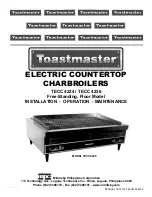
/
65
MAINTENANCE
Maintenance is an essential part of the safe and efficient
operation of the boiler and ensures its durability. It should
be performed according to the instructions given in current
legislation. Perform combustion analysis regularly in order to
check the operating efficiency of the boiler and to make sure
any polluting substances released are within the boudaries set
by current legislation.
Before beginning maintenance work:
- Disconnect the appliance from the electricity supply by
turning the external bipolar switch to the “OFF” position;
- Close the gas valve and the central heating and domestic
hot water system valves.
After the work has been completed the initial settings will be
restored.
General comments
It is recommended that the following inspections be carried out
on the boiler at least once a year:
1. Check the seals in the water part and, if necessary, replace
the gaskets and restore the seal to perfect working order.
2. Check the seals in the gas part and, if necessary, replace
the gaskets and restore the seal to perfect working order.
3. Visually check the overall condition of the boiler.
4. Visually check the combustion and, if necessary,
disassemble and clean the burner.
5. Following the inspection detailed in point “3”, disassemble
and clean the combustion chamber, if necessary.
6. Following the inspection detailed in point “4”, disassemble
and clean the burner and injector, if necessary.
7. Cleaning the primary heat exchanger
8. Make sure the following heating safety devices are operating
correctly:
- temperature limit safety device.
9. Make sure that the following gas part safety devices are
operating correctly:
- absence of gas or flame safety device (ionisation).
10. Check the efficiency of the domestic hot water production
process (test the flow rate and temperature).
11. Perform a general inspection of the boiler operation.
Operational test
After having carried out the maintenance operations, fill the
heating circuit at a pressure of approximately 1.5 bar and
release the air from the system.
Fill the domestic hot water system at the same time.
- Begin operating the boiler.
- If necessary, release the air from the heating system again.
- Check the settings and make sure all the command,
adjustment and monitoring parts are working correctly.
- Check the flue system is sealed and operating correctly.
Draining procedures
The heating system must be drained using the following
procedure:
- Switch off the boiler, make sure the external bipolar switch is
in the OFF position and shut off the gas valve;
- Loosen the automatic air relief valve;
- Open the system drain off cock and collect the escaping water
in a container;
- Empty the water from the lowest points of the system (where
applicable).
If the system is to be left inactive in areas where the room
temperature may fall below 0°C during winter, we recommend
that anti-freeze liquid is added to the water in the heating system
in order to avoid the need for repeated draining; when this liquid
is used make sure it is compatible with the stainless steel used
for the bodywork of the boiler.
We recommend the use of anti-freeze products which contain
PROPYLENE GLYCOLS as these inhibit corrosion and that they
are used in conjunction with the anti-scaling and anti-corrosion
function, in the quantities suggested by the manufacturer, at the
mimimum temperature.
Regularly check the pH level of the water/anti-freeze mix in the
boiler circuit and replace it when the value measured is lower
than the limit prescribed by the manufacturer.
DO NOT MIX DIFFERENT TYPES OF ANTI-FREEZE.
The manufacturer will not be held liable for any damage caused
by the appliance or the system due to the use of inappropriate
anti-freeze substances or additives.
Draining the domestic hot water system and indirect
cylinder
Every time there is a danger of freezing, the domestic hot water
system must be drained as follows:
- Shut off the water mains inlet valve;
- Open all the hot and cold water taps;
- Empty the water from the lowest points of the system (where
applicable).
WARNING
Before handling, empty all components which may contain hot
water, performing bleeding where necessary.
Descale the components in accordance with the instructions
provided on the safety data leaflet supplied with the product
used, make sure the room is well ventilated, wear protective
clothing, avoid mixing different products, and protect the
appliance and surrounding objects.
Seal all openings used to take a gas pressure reading or to
make any gas adjustments.
Make sure that the nozzle is compatible with the supplied gas.
If a smell of burning is detected or smoke is seen leaking from
the appliance, or there is a smell of gas, disconnect it from the
electricity supply, shut off the gas valve, open the windows and
call for technical assistance.
User information
Inform the user on the appliance’s operating modes. In particular
provide the user with the instruction manual, informing them that
it must be kept near the appliance.
Additionally, inform the user on the tasks required of them:
- To periodically check the appliance’s water pressure,
- To re-establish the pressure and degas the appliance if
necessary,
- To adjust the thresholds and the settings devices for correct
and more economical operation of the appliance,
- To have the appliance serviced, as required by the regulations,
- To not modify, under any circumstances, the combustion air
supply and combustion gas settings.
Содержание 3636085
Страница 42: ......




































